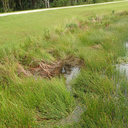The potent anti-tumor-promoting agent isoliquiritigenin.
Cuvinte cheie
Abstract
A topical application of a chalcone derivative, 4,2',4'-trihydroxychalcone (isoliquiritigenin) inhibited epidermal ornithine decarboxylase (ODC) induction and ear edema formation, i.e. inflammation, caused by a topical application of 12-O-tetradecanoylphorbol-13-acetate (TPA) in CD-1 mice. In addition, isoliquiritigenin potently inhibited 7,12-dimethylbenz[alpha]anthracene (DMBA)-initiated and TPA-promoted skin papilloma formation. This inhibitory effect of isoliquiritigenin was not due to any damage inflicted on the initiated cells but due to its anti-tumor-promoting action. Isoliquiritigenin also inhibited epidermal ODC induction and skin tumor promotion caused by 7-bromomethylbenz[alpha]anthracene (BrMBA), a non-TPA type of tumor-promoting agent, in DMBA-initiated mice. Isoliquiritigenin inhibits neither 12-lipoxygenase nor cyclooxygenase in epidermal subcellular fractions. This compound, however, inhibited TPA-stimulated prostaglandin E2 (PGE2) production in intact epidermal cells. ODC induction caused by TPA was inhibited by a topical application of cyclooxygenase inhibitor, indomethacin. Inhibition of ODC induction by indomethacin was counteracted by a topical application of PGE2, while inhibition caused by isoliquiritigenin was not overcome by PGE2. The results suggest that a mechanism other than the inhibition of PGE2 production is involved in the anti-tumor-promoting action of isoliquiritigenin. Isoliquiritigenin failed to inhibit phospholipase A2 activity of platelet sonicates, but inhibited platelet 12-lipoxygenase and 5-lipoxygenase in polymorphonuclear leukocytes. Therefore, it might be possible that isoliquiritigenin exerts its anti-tumor-promoting action through the lipoxygenase inhibition by acting on cells other than the target epidermal cells. Our present results, in combination with our previous data, demonstrate that some chalcone derivatives and flavonoids which show a potent lipoxygenase inhibitory action act on a common step in the skin tumor promotion caused by two different types of tumor-promoting agents, i.e. TPA and BrMBA, and suggest that these compounds show promise as drugs to prevent tumor promotion.



